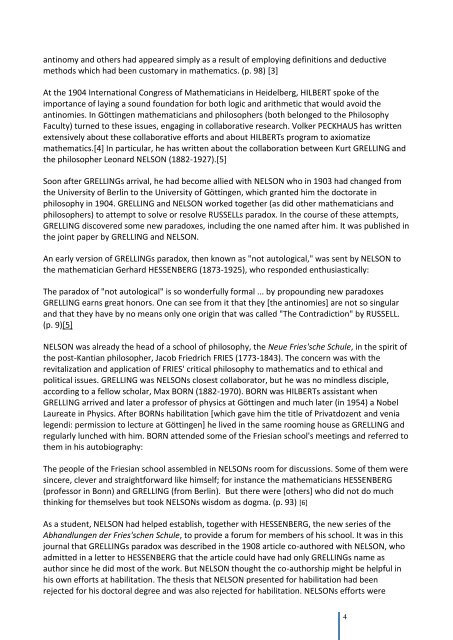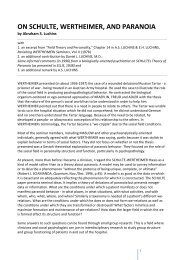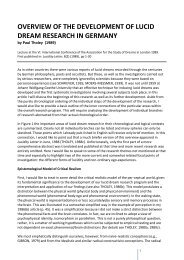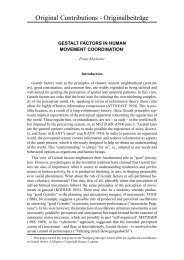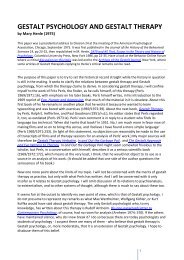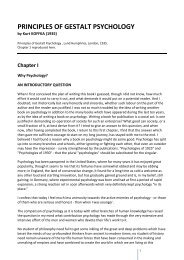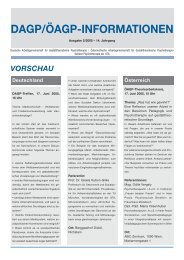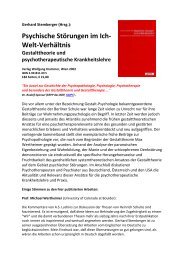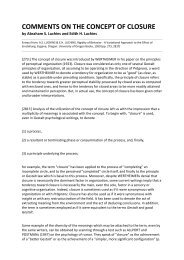pdf-Download - Society for Gestalt Theory and its Applications (GTA)
pdf-Download - Society for Gestalt Theory and its Applications (GTA)
pdf-Download - Society for Gestalt Theory and its Applications (GTA)
You also want an ePaper? Increase the reach of your titles
YUMPU automatically turns print PDFs into web optimized ePapers that Google loves.
antinomy <strong>and</strong> others had appeared simply as a result of employing definitions <strong>and</strong> deductive<br />
methods which had been customary in mathematics. (p. 98) [3]<br />
At the 1904 International Congress of Mathematicians in Heidelberg, HILBERT spoke of the<br />
importance of laying a sound foundation <strong>for</strong> both logic <strong>and</strong> arithmetic that would avoid the<br />
antinomies. In Göttingen mathematicians <strong>and</strong> philosophers (both belonged to the Philosophy<br />
Faculty) turned to these issues, engaging in collaborative research. Volker PECKHAUS has written<br />
extensively about these collaborative ef<strong>for</strong>ts <strong>and</strong> about HILBERTs program to axiomatize<br />
mathematics.[4] In particular, he has written about the collaboration between Kurt GRELLING <strong>and</strong><br />
the philosopher Leonard NELSON (1882-1927).[5]<br />
Soon after GRELLINGs arrival, he had become allied with NELSON who in 1903 had changed from<br />
the University of Berlin to the University of Göttingen, which granted him the doctorate in<br />
philosophy in 1904. GRELLING <strong>and</strong> NELSON worked together (as did other mathematicians <strong>and</strong><br />
philosophers) to attempt to solve or resolve RUSSELLs paradox. In the course of these attempts,<br />
GRELLING discovered some new paradoxes, including the one named after him. It was published in<br />
the joint paper by GRELLING <strong>and</strong> NELSON.<br />
An early version of GRELLINGs paradox, then known as "not autological," was sent by NELSON to<br />
the mathematician Gerhard HESSENBERG (1873-1925), who responded enthusiastically:<br />
The paradox of "not autological" is so wonderfully <strong>for</strong>mal ... by propounding new paradoxes<br />
GRELLING earns great honors. One can see from it that they [the antinomies] are not so singular<br />
<strong>and</strong> that they have by no means only one origin that was called "The Contradiction" by RUSSELL.<br />
(p. 9)[5]<br />
NELSON was already the head of a school of philosophy, the Neue Fries'sche Schule, in the spirit of<br />
the post-Kantian philosopher, Jacob Friedrich FRIES (1773-1843). The concern was with the<br />
revitalization <strong>and</strong> application of FRIES' critical philosophy to mathematics <strong>and</strong> to ethical <strong>and</strong><br />
political issues. GRELLING was NELSONs closest collaborator, but he was no mindless disciple,<br />
according to a fellow scholar, Max BORN (1882-1970). BORN was HILBERTs assistant when<br />
GRELLING arrived <strong>and</strong> later a professor of physics at Göttingen <strong>and</strong> much later (in 1954) a Nobel<br />
Laureate in Physics. After BORNs habilitation [which gave him the title of Privatdozent <strong>and</strong> venia<br />
legendi: permission to lecture at Göttingen] he lived in the same rooming house as GRELLING <strong>and</strong><br />
regularly lunched with him. BORN attended some of the Friesian school's meetings <strong>and</strong> referred to<br />
them in his autobiography:<br />
The people of the Friesian school assembled in NELSONs room <strong>for</strong> discussions. Some of them were<br />
sincere, clever <strong>and</strong> straight<strong>for</strong>ward like himself; <strong>for</strong> instance the mathematicians HESSENBERG<br />
(professor in Bonn) <strong>and</strong> GRELLING (from Berlin). But there were [others] who did not do much<br />
thinking <strong>for</strong> themselves but took NELSONs wisdom as dogma. (p. 93) [6]<br />
As a student, NELSON had helped establish, together with HESSENBERG, the new series of the<br />
Abh<strong>and</strong>lungen der Fries'schen Schule, to provide a <strong>for</strong>um <strong>for</strong> members of his school. It was in this<br />
journal that GRELLINGs paradox was described in the 1908 article co-authored with NELSON, who<br />
admitted in a letter to HESSENBERG that the article could have had only GRELLINGs name as<br />
author since he did most of the work. But NELSON thought the co-authorship might be helpful in<br />
his own ef<strong>for</strong>ts at habilitation. The thesis that NELSON presented <strong>for</strong> habilitation had been<br />
rejected <strong>for</strong> his doctoral degree <strong>and</strong> was also rejected <strong>for</strong> habilitation. NELSONs ef<strong>for</strong>ts were<br />
4


